Page 25 of 82
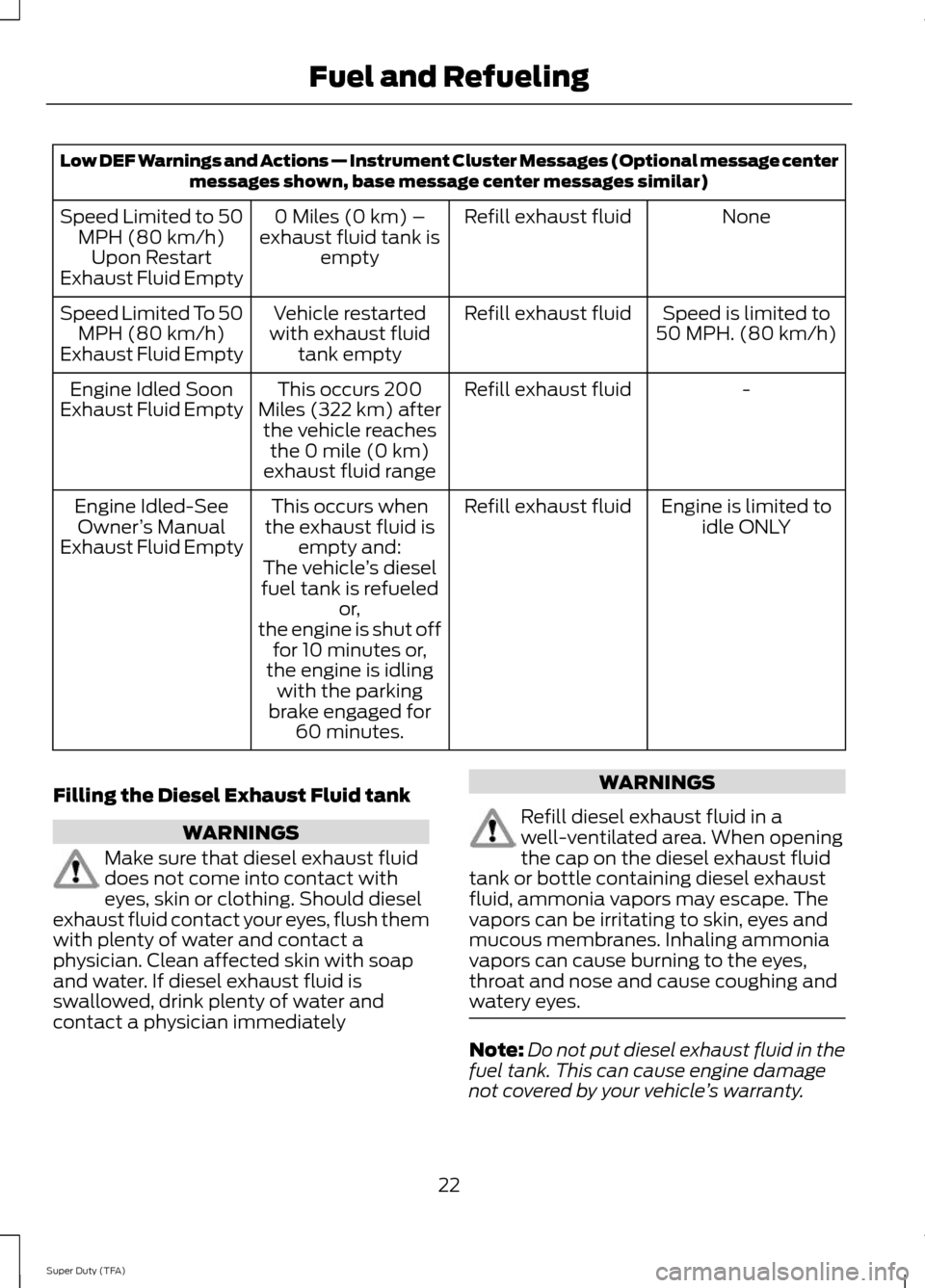
Low DEF Warnings and Actions — Instrument Cluster Messages (Optional message center
messages shown, base message center messages similar)
None
Refill exhaust fluid
0 Miles (0 km) –
exhaust fluid tank is empty
Speed Limited to 50
MPH (80 km/h)Upon Restart
Exhaust Fluid Empty
Speed is limited to
50 MPH. (80 km/h)
Refill exhaust fluid
Vehicle restarted
with exhaust fluid tank empty
Speed Limited To 50
MPH (80 km/h)
Exhaust Fluid Empty
-
Refill exhaust fluid
This occurs 200
Miles (322 km) after the vehicle reaches the 0 mile (0 km)
exhaust fluid range
Engine Idled Soon
Exhaust Fluid Empty
Engine is limited toidle ONLY
Refill exhaust fluid
This occurs when
the exhaust fluid is empty and:
Engine Idled-See
Owner ’s Manual
Exhaust Fluid Empty The vehicle’s diesel
fuel tank is refueled or,
the engine is shut off for 10 minutes or,
the engine is idling with the parking
brake engaged for 60 minutes.
Filling the Diesel Exhaust Fluid tank WARNINGS
Make sure that diesel exhaust fluid
does not come into contact with
eyes, skin or clothing. Should diesel
exhaust fluid contact your eyes, flush them
with plenty of water and contact a
physician. Clean affected skin with soap
and water. If diesel exhaust fluid is
swallowed, drink plenty of water and
contact a physician immediately WARNINGS
Refill diesel exhaust fluid in a
well-ventilated area. When opening
the cap on the diesel exhaust fluid
tank or bottle containing diesel exhaust
fluid, ammonia vapors may escape. The
vapors can be irritating to skin, eyes and
mucous membranes. Inhaling ammonia
vapors can cause burning to the eyes,
throat and nose and cause coughing and
watery eyes. Note:
Do not put diesel exhaust fluid in the
fuel tank. This can cause engine damage
not covered by your vehicle ’s warranty.
22
Super Duty (TFA) Fuel and Refueling
Page 26 of 82
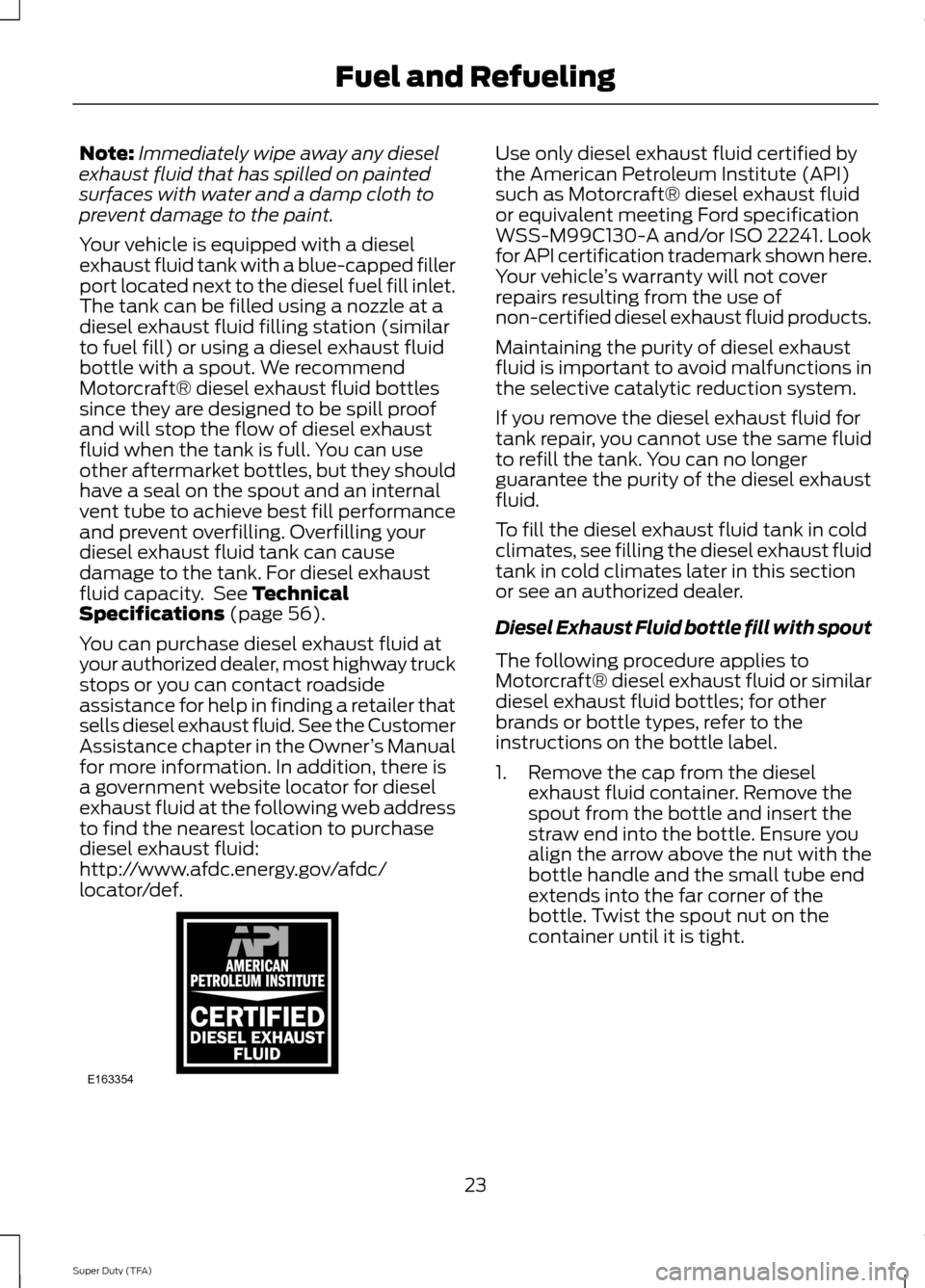
Note:
Immediately wipe away any diesel
exhaust fluid that has spilled on painted
surfaces with water and a damp cloth to
prevent damage to the paint.
Your vehicle is equipped with a diesel
exhaust fluid tank with a blue-capped filler
port located next to the diesel fuel fill inlet.
The tank can be filled using a nozzle at a
diesel exhaust fluid filling station (similar
to fuel fill) or using a diesel exhaust fluid
bottle with a spout. We recommend
Motorcraft® diesel exhaust fluid bottles
since they are designed to be spill proof
and will stop the flow of diesel exhaust
fluid when the tank is full. You can use
other aftermarket bottles, but they should
have a seal on the spout and an internal
vent tube to achieve best fill performance
and prevent overfilling. Overfilling your
diesel exhaust fluid tank can cause
damage to the tank. For diesel exhaust
fluid capacity. See Technical
Specifications (page 56).
You can purchase diesel exhaust fluid at
your authorized dealer, most highway truck
stops or you can contact roadside
assistance for help in finding a retailer that
sells diesel exhaust fluid. See the Customer
Assistance chapter in the Owner ’s Manual
for more information. In addition, there is
a government website locator for diesel
exhaust fluid at the following web address
to find the nearest location to purchase
diesel exhaust fluid:
http://www.afdc.energy.gov/afdc/
locator/def. Use only diesel exhaust fluid certified by
the American Petroleum Institute (API)
such as Motorcraft® diesel exhaust fluid
or equivalent meeting Ford specification
WSS-M99C130-A and/or ISO 22241. Look
for API certification trademark shown here.
Your vehicle
’s warranty will not cover
repairs resulting from the use of
non-certified diesel exhaust fluid products.
Maintaining the purity of diesel exhaust
fluid is important to avoid malfunctions in
the selective catalytic reduction system.
If you remove the diesel exhaust fluid for
tank repair, you cannot use the same fluid
to refill the tank. You can no longer
guarantee the purity of the diesel exhaust
fluid.
To fill the diesel exhaust fluid tank in cold
climates, see filling the diesel exhaust fluid
tank in cold climates later in this section
or see an authorized dealer.
Diesel Exhaust Fluid bottle fill with spout
The following procedure applies to
Motorcraft® diesel exhaust fluid or similar
diesel exhaust fluid bottles; for other
brands or bottle types, refer to the
instructions on the bottle label.
1. Remove the cap from the diesel exhaust fluid container. Remove the
spout from the bottle and insert the
straw end into the bottle. Ensure you
align the arrow above the nut with the
bottle handle and the small tube end
extends into the far corner of the
bottle. Twist the spout nut on the
container until it is tight.
23
Super Duty (TFA) Fuel and RefuelingE163354)E163354
Page 27 of 82
2.
Open the diesel exhaust fluid filler port
on your vehicle by turning the blue cap
counterclockwise. Do not put diesel
exhaust fluid in the fuel tank. This can
cause engine damage not covered by
your vehicle ’s warranty. 3. Lift and hold the diesel exhaust fluid
container, without tipping, and insert
the spout into the diesel exhaust fluid
filler port until the small black seal on
the spout completely seats into the
filler port. 4.
While filling, the fluid level in the bottle
will continually drop. 5. When the diesel exhaust fluid tank is
full, the fluid level in the bottle will stop
dropping, indicating the fluid has
stopped flowing. 24
Super Duty (TFA) Fuel and RefuelingE163355 E163356 E163357 E163358 E163359
Page 28 of 82
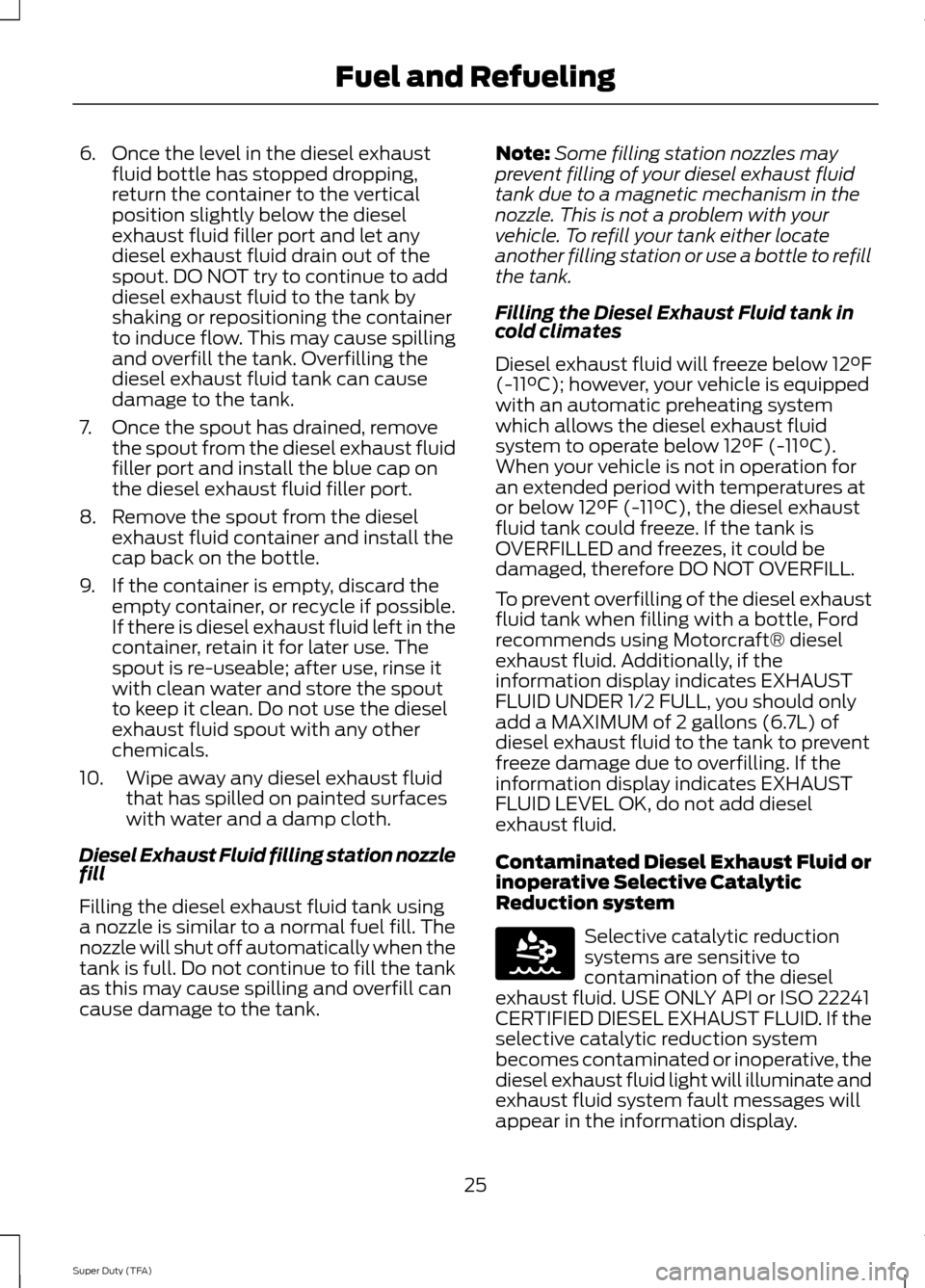
6. Once the level in the diesel exhaust
fluid bottle has stopped dropping,
return the container to the vertical
position slightly below the diesel
exhaust fluid filler port and let any
diesel exhaust fluid drain out of the
spout. DO NOT try to continue to add
diesel exhaust fluid to the tank by
shaking or repositioning the container
to induce flow. This may cause spilling
and overfill the tank. Overfilling the
diesel exhaust fluid tank can cause
damage to the tank.
7. Once the spout has drained, remove the spout from the diesel exhaust fluid
filler port and install the blue cap on
the diesel exhaust fluid filler port.
8. Remove the spout from the diesel exhaust fluid container and install the
cap back on the bottle.
9. If the container is empty, discard the empty container, or recycle if possible.
If there is diesel exhaust fluid left in the
container, retain it for later use. The
spout is re-useable; after use, rinse it
with clean water and store the spout
to keep it clean. Do not use the diesel
exhaust fluid spout with any other
chemicals.
10. Wipe away any diesel exhaust fluid that has spilled on painted surfaces
with water and a damp cloth.
Diesel Exhaust Fluid filling station nozzle
fill
Filling the diesel exhaust fluid tank using
a nozzle is similar to a normal fuel fill. The
nozzle will shut off automatically when the
tank is full. Do not continue to fill the tank
as this may cause spilling and overfill can
cause damage to the tank. Note:
Some filling station nozzles may
prevent filling of your diesel exhaust fluid
tank due to a magnetic mechanism in the
nozzle. This is not a problem with your
vehicle. To refill your tank either locate
another filling station or use a bottle to refill
the tank.
Filling the Diesel Exhaust Fluid tank in
cold climates
Diesel exhaust fluid will freeze below 12°F
(-11°C); however, your vehicle is equipped
with an automatic preheating system
which allows the diesel exhaust fluid
system to operate below 12°F (-11°C).
When your vehicle is not in operation for
an extended period with temperatures at
or below 12°F (-11°C), the diesel exhaust
fluid tank could freeze. If the tank is
OVERFILLED and freezes, it could be
damaged, therefore DO NOT OVERFILL.
To prevent overfilling of the diesel exhaust
fluid tank when filling with a bottle, Ford
recommends using Motorcraft® diesel
exhaust fluid. Additionally, if the
information display indicates EXHAUST
FLUID UNDER 1/2 FULL, you should only
add a MAXIMUM of 2 gallons (6.7L) of
diesel exhaust fluid to the tank to prevent
freeze damage due to overfilling. If the
information display indicates EXHAUST
FLUID LEVEL OK, do not add diesel
exhaust fluid.
Contaminated Diesel Exhaust Fluid or
inoperative Selective Catalytic
Reduction system Selective catalytic reduction
systems are sensitive to
contamination of the diesel
exhaust fluid. USE ONLY API or ISO 22241
CERTIFIED DIESEL EXHAUST FLUID. If the
selective catalytic reduction system
becomes contaminated or inoperative, the
diesel exhaust fluid light will illuminate and
exhaust fluid system fault messages will
appear in the information display.
25
Super Duty (TFA) Fuel and RefuelingE163176
Page 29 of 82

Continued driving without replacing diesel
exhaust fluid or having the selective
catalytic reduction system repaired will
result in the following actions as required
by the California Air Resources Board
(CARB) and U.S. Environmental Protection
Agency (EPA):
•
Within a certain number of miles
(kilometers) to empty, speed will be
limited upon restart. Prior to this
occurring a message will appear in the
information display.
• Further vehicle operation without
replacing contaminated diesel exhaust
fluid will cause the engine to enter an
idle-only condition. This will only occur
upon vehicle refueling, vehicle idling in
park for 1 hour, or engine shutdown for
10 minutes or more and will be
indicated by a message in the
information display indicating required
actions to resume normal operation.
For either vehicle speed limiting or idle-only
condition, normal vehicle operation will
resume when you repair the contaminated
system. To service a contaminated or
inoperative system, see an authorized
dealer.
Diesel Exhaust Fluid guidelines and
information
• Use only diesel exhaust fluid that
carries the trademark: American
Petroleum Institute (API) certified DEF
or ISO 22241.
• Do not put diesel exhaust fluid in the
diesel fuel tank.
• Do not overfill the diesel exhaust fluid
tank. •
Do not re-use the diesel exhaust fluid
container once it is emptied.
• Avoid spilling diesel exhaust fluid on
painted surfaces, carpeting or plastic
components. Immediately wipe away
any diesel exhaust fluid that has spilled
with a damp cloth and water. If it has
already crystallized, use warm water
and a sponge.
• Store diesel exhaust fluid out of direct
sunlight and in temperatures between
23°F (-5°C) — 68°F (20°C).
• Diesel exhaust fluid will freeze below
12°F (-11°C).
• Do not store the diesel exhaust fluid
bottle in your vehicle. If it leaks it could
cause damage to interior components
or release an ammonia odor inside your
vehicle.
• Diesel exhaust fluid is non-flammable,
non-toxic, colorless and water-soluble
liquid.
• Do not dilute diesel exhaust fluid with
water or any other liquid.
• An ammonia odor may be smelled
when the cap is removed or during
refill. Refill diesel exhaust fluid in a well
ventilated area.
Typical Diesel Exhaust Fluid Usage
The charts below illustrate approximate
diesel exhaust fluid usage for the given
distances traveled under various driving
conditions and when using the power take
off. Your usage may vary depending on:
driving style, trailer towing, loaded vehicle
weight, weather, idle time, PTO usage.
26
Super Duty (TFA) Fuel and Refueling
Page 30 of 82
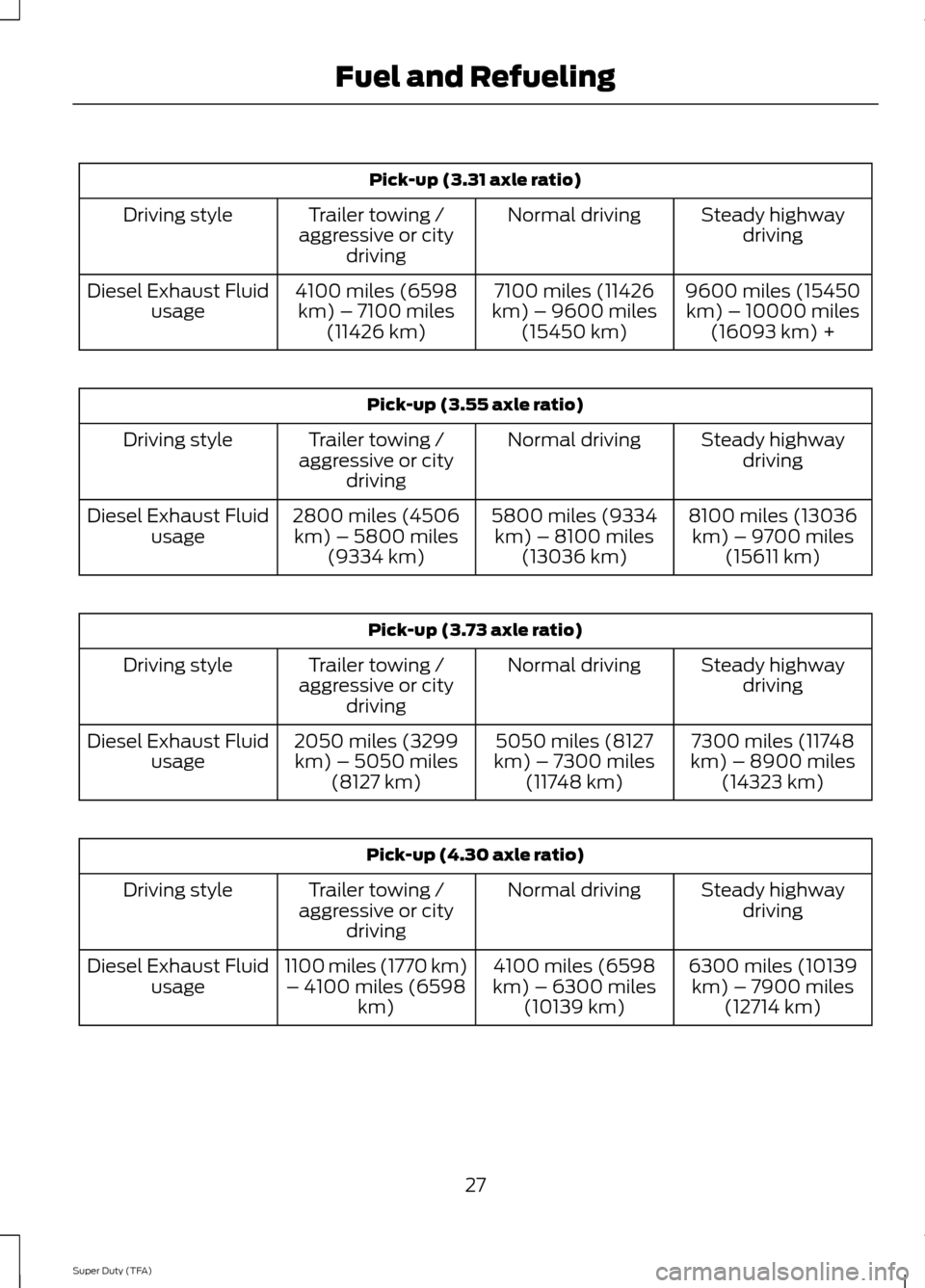
Pick-up (3.31 axle ratio)
Steady highwaydriving
Normal driving
Trailer towing /
aggressive or city driving
Driving style
9600 miles (15450km) – 10000 miles (16093 km) +
7100 miles (11426
km) – 9600 miles (15450 km)
4100 miles (6598
km) – 7100 miles (11426 km)
Diesel Exhaust Fluid
usage Pick-up (3.55 axle ratio)
Steady highwaydriving
Normal driving
Trailer towing /
aggressive or city driving
Driving style
8100 miles (13036km) – 9700 miles (15611 km)
5800 miles (9334
km) – 8100 miles (13036 km)
2800 miles (4506
km) – 5800 miles (9334 km)
Diesel Exhaust Fluid
usage Pick-up (3.73 axle ratio)
Steady highwaydriving
Normal driving
Trailer towing /
aggressive or city driving
Driving style
7300 miles (11748
km) – 8900 miles (14323 km)
5050 miles (8127
km) – 7300 miles (11748 km)
2050 miles (3299
km) – 5050 miles (8127 km)
Diesel Exhaust Fluid
usage Pick-up (4.30 axle ratio)
Steady highwaydriving
Normal driving
Trailer towing /
aggressive or city driving
Driving style
6300 miles (10139km) – 7900 miles (12714 km)
4100 miles (6598
km) – 6300 miles (10139 km)
1100 miles (1770 km)
– 4100 miles (6598 km)
Diesel Exhaust Fluid
usage
27
Super Duty (TFA) Fuel and Refueling
Page 31 of 82
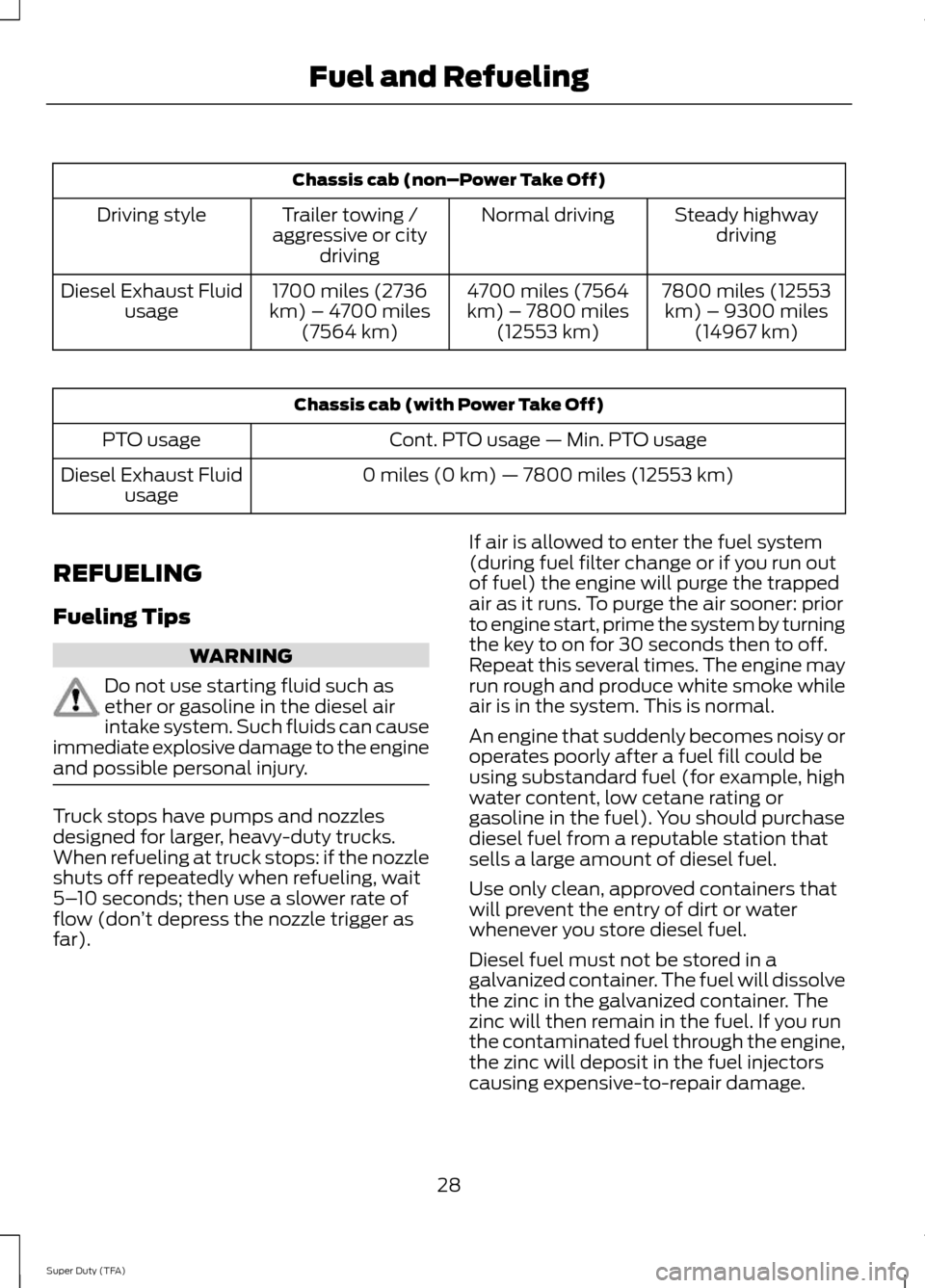
Chassis cab (non–Power Take Off)
Steady highwaydriving
Normal driving
Trailer towing /
aggressive or city driving
Driving style
7800 miles (12553km) – 9300 miles (14967 km)
4700 miles (7564
km) – 7800 miles (12553 km)
1700 miles (2736
km) – 4700 miles (7564 km)
Diesel Exhaust Fluid
usage Chassis cab (with Power Take Off)
Cont. PTO usage — Min. PTO usage
PTO usage
0 miles (0 km) — 7800 miles (12553 km)
Diesel Exhaust Fluid
usage
REFUELING
Fueling Tips WARNING
Do not use starting fluid such as
ether or gasoline in the diesel air
intake system. Such fluids can cause
immediate explosive damage to the engine
and possible personal injury. Truck stops have pumps and nozzles
designed for larger, heavy-duty trucks.
When refueling at truck stops: if the nozzle
shuts off repeatedly when refueling, wait
5–
10 seconds; then use a slower rate of
flow (don ’t depress the nozzle trigger as
far). If air is allowed to enter the fuel system
(during fuel filter change or if you run out
of fuel) the engine will purge the trapped
air as it runs. To purge the air sooner: prior
to engine start, prime the system by turning
the key to on for 30 seconds then to off.
Repeat this several times. The engine may
run rough and produce white smoke while
air is in the system. This is normal.
An engine that suddenly becomes noisy or
operates poorly after a fuel fill could be
using substandard fuel (for example, high
water content, low cetane rating or
gasoline in the fuel). You should purchase
diesel fuel from a reputable station that
sells a large amount of diesel fuel.
Use only clean, approved containers that
will prevent the entry of dirt or water
whenever you store diesel fuel.
Diesel fuel must not be stored in a
galvanized container. The fuel will dissolve
the zinc in the galvanized container. The
zinc will then remain in the fuel. If you run
the contaminated fuel through the engine,
the zinc will deposit in the fuel injectors
causing expensive-to-repair damage.
28
Super Duty (TFA) Fuel and Refueling
Page 32 of 82
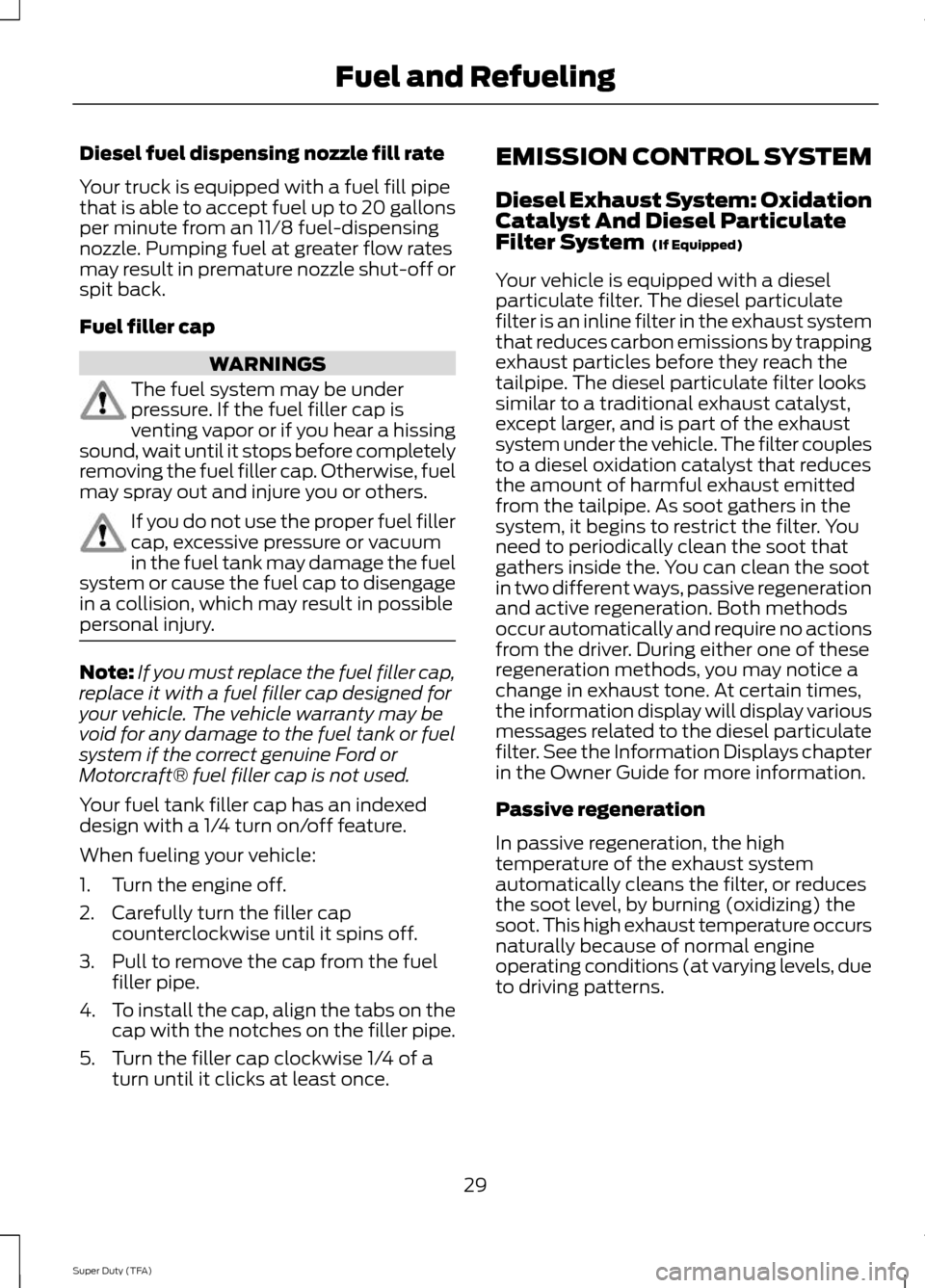
Diesel fuel dispensing nozzle fill rate
Your truck is equipped with a fuel fill pipe
that is able to accept fuel up to 20 gallons
per minute from an 11⁄8 fuel-dispensing
nozzle. Pumping fuel at greater flow rates
may result in premature nozzle shut-off or
spit back.
Fuel filler cap
WARNINGS
The fuel system may be under
pressure. If the fuel filler cap is
venting vapor or if you hear a hissing
sound, wait until it stops before completely
removing the fuel filler cap. Otherwise, fuel
may spray out and injure you or others. If you do not use the proper fuel filler
cap, excessive pressure or vacuum
in the fuel tank may damage the fuel
system or cause the fuel cap to disengage
in a collision, which may result in possible
personal injury. Note:
If you must replace the fuel filler cap,
replace it with a fuel filler cap designed for
your vehicle. The vehicle warranty may be
void for any damage to the fuel tank or fuel
system if the correct genuine Ford or
Motorcraft® fuel filler cap is not used.
Your fuel tank filler cap has an indexed
design with a 1/4 turn on/off feature.
When fueling your vehicle:
1. Turn the engine off.
2. Carefully turn the filler cap counterclockwise until it spins off.
3. Pull to remove the cap from the fuel filler pipe.
4. To install the cap, align the tabs on the
cap with the notches on the filler pipe.
5. Turn the filler cap clockwise 1/4 of a turn until it clicks at least once. EMISSION CONTROL SYSTEM
Diesel Exhaust System: Oxidation
Catalyst And Diesel Particulate
Filter System (If Equipped)
Your vehicle is equipped with a diesel
particulate filter. The diesel particulate
filter is an inline filter in the exhaust system
that reduces carbon emissions by trapping
exhaust particles before they reach the
tailpipe. The diesel particulate filter looks
similar to a traditional exhaust catalyst,
except larger, and is part of the exhaust
system under the vehicle. The filter couples
to a diesel oxidation catalyst that reduces
the amount of harmful exhaust emitted
from the tailpipe. As soot gathers in the
system, it begins to restrict the filter. You
need to periodically clean the soot that
gathers inside the. You can clean the soot
in two different ways, passive regeneration
and active regeneration. Both methods
occur automatically and require no actions
from the driver. During either one of these
regeneration methods, you may notice a
change in exhaust tone. At certain times,
the information display will display various
messages related to the diesel particulate
filter. See the Information Displays chapter
in the Owner Guide for more information.
Passive regeneration
In passive regeneration, the high
temperature of the exhaust system
automatically cleans the filter, or reduces
the soot level, by burning (oxidizing) the
soot. This high exhaust temperature occurs
naturally because of normal engine
operating conditions (at varying levels, due
to driving patterns.
29
Super Duty (TFA) Fuel and Refueling